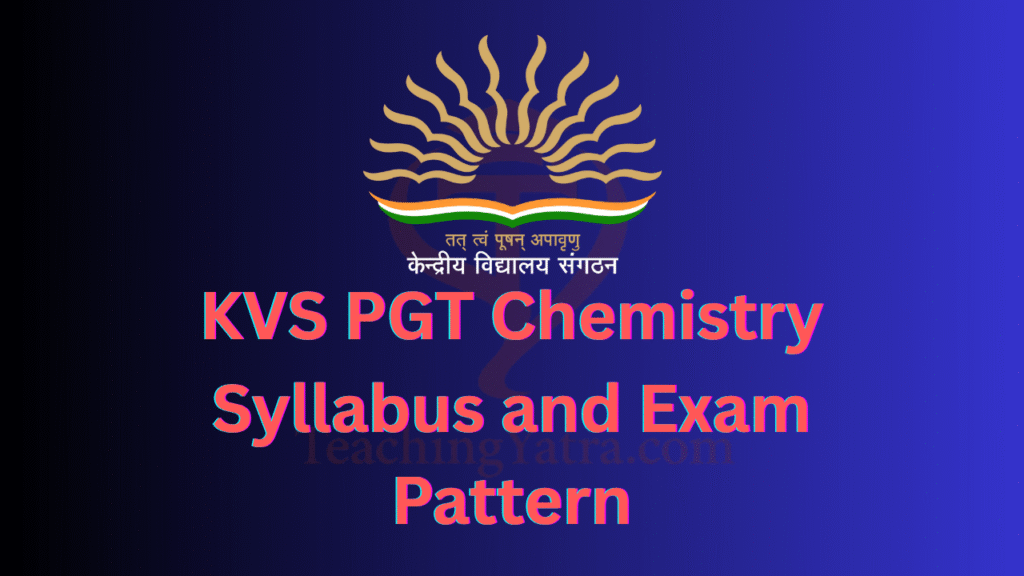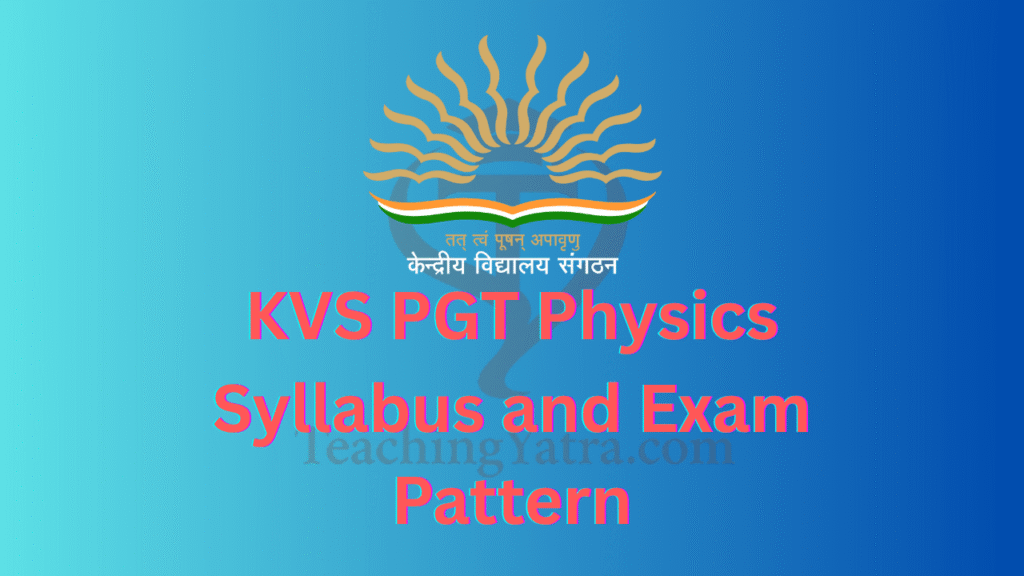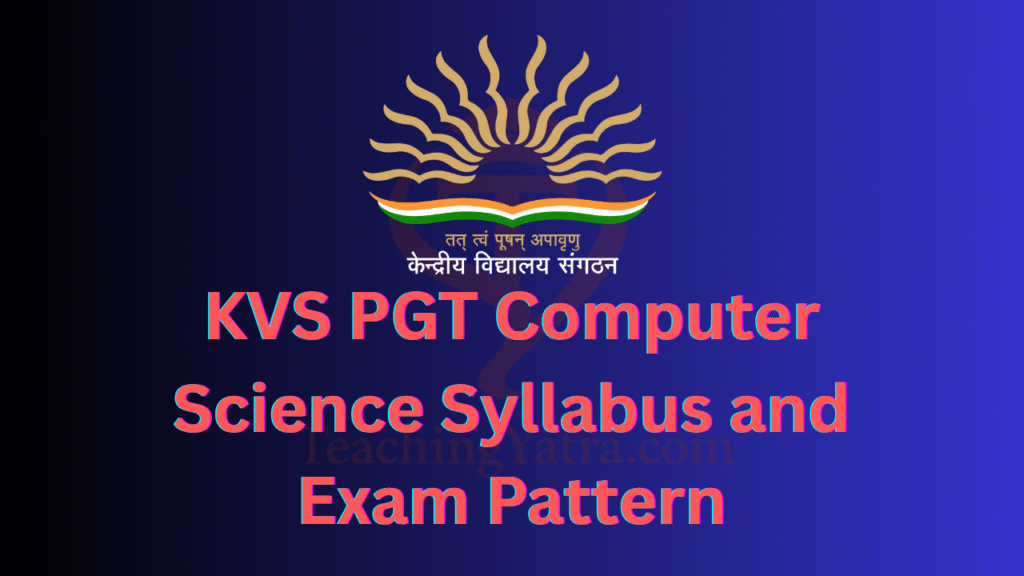
KVS PGT Chemistry Syllabus and Exam Pattern 2025 : The KVS PGT Chemistry syllabus tells you what topics you need to study for the exam. It includes important parts of Physical, Organic, and Inorganic Chemistry, mainly from Class 11 and 12 NCERT books. But the questions will be asked at a higher (postgraduate) level. If you understand the syllabus well and follow a good study plan, it will help you prepare better and increase your chances of success in the exam.
Table of Contents
KVS Post Graduate Teacher Chemistry Syllabus: Overview
The KVS PGT Chemistry Syllabus 2025 explains the important subjects and topics that candidates need to study for the Kendriya Vidyalaya Sangathan (KVS) recruitment exam. To do well, candidates should follow the latest official updates and study the syllabus carefully. A planned and focused preparation based on the syllabus will help increase the chances of getting selected for the PGT Chemistry post.
KVS PGT Chemistry Exam Pattern 2025
Before starting preparation, it is important to understand the exam pattern. It gives useful information like number of questions, total marks, marking scheme, and more. This helps candidates make a better study plan. See the table below for details like exam time, sections, language, and type of questions.
| Part | Section | Marks |
|---|---|---|
| Part I | General English | 10 marks |
| General Hindi | 10 marks | |
| Part II | General Awareness | 10 marks |
| Reasoning Ability | 5 marks | |
| Computer Literacy | 5 marks | |
| Part III | Perspectives on Education & Leadership | 40 marks |
| Part IV | Chemistry Subject Knowledge | 100 marks |
Detailed KVS PGT Chemistry Syllabus 2025
Subject specific syllabus includes the concepts of NCERT/CBSE syllabus and Text Books (Classes XI & XII), however, the questions will be testing the depth of understanding and application of these concepts at the level of Post- Graduation.
Basic Concepts of Chemistry
General Introduction: Importance and scope of Chemistry. Nature of matter, laws of chemical combination, Dalton’s atomic theory: concept of elements, atoms and molecules. Atomic and molecular masses, mole concept and molar mass, percentage composition, empirical and molecular formula, chemical reactions, stoichiometry and calculations based on stoichiometry.
Structure of Atom
Discovery of Electron, Proton and Neutron, atomic number, isotopes and isobars. Thomson’s model and its limitations. Rutherford’s model and its limitations, Bohr’s model and its limitations, concept of shells and subshells, dual nature of matter and light, de Broglie’s relationship, Heisenberg uncertainty principle, concept of orbitals, quantum numbers, shapes of s, p and d orbitals, rules for filling electrons in orbitals – Aufbau principle, Pauli’s exclusion principle and Hund’s rule, electronic configuration of atoms, stability of half-filled and completely filled orbitals.
Classification of Elements and Periodicity in Properties
Significance of classification, brief history of the development of periodic table, modern periodic law and the present form of periodic table, periodic trends in properties of elements – atomic radii, ionic radii, inert gas radii, Ionization enthalpy, electron gain enthalpy, electronegativity, valency. Nomenclature of elements with atomic number greater than 100.
Chemical Bonding and Molecular Structure
Valence electrons, ionic bond, covalent bond, bond parameters, Lewis structure, polar character of covalent bond, covalent character of ionic bond, valence bond theory, resonance, geometry of covalent molecules, VSEPR theory, concept of hybridization, involving s, p and d orbitals and shapes of some simple molecules, molecular orbital theory of homonuclear diatomic molecules (qualitative idea only), Hydrogen bond.
Chemical Thermodynamics
Concepts of System and types of systems, surroundings, work, heat, energy, extensive and intensive properties, state functions. First law of thermodynamics – internal energy and enthalpy, heat capacity and specific heat, measurement of ∆U & ∆H, Hess’s law of constant heat summation, enthalpy of bond of dissociation, combustion, formation, atomization, sublimation, phase transition, ionization, solution and dilution. Second law of Thermodynamics, Introduction of entropy as a state function, Gibb’s energy change for spontaneous and nonspontaneous processes, criteria for equilibrium. Third law of thermodynamics.
Equilibrium
Equilibrium in physical and chemical processes, dynamic nature of equilibrium, law of mass action, equilibrium constant, factors affecting equilibrium – Le Chatelier’s principle, ionic equilibrium – ionization of acids and bases, strong and weak electrolytes, degree of ionization, ionization of polybasic acids, acid strength, concept of pH, hydrolysis of salts (elementary idea), buffer solution, Henderson Equation, solubility product, common ion effect (with illustrative examples).
Redox Reactions
Concept of oxidation and reduction, redox reactions, oxidation number, balancing redox reactions, in terms of loss and gain of electrons and change in oxidation number, applications of redox reactions.
Organic Chemistry – Some Basic Principles and Techniques
General introduction, methods of purification, qualitative and quantitative analysis, classification and IUPAC nomenclature of organic compounds. Electronic displacements in a covalent bond: inductive effect, electromeric effect, resonance and hyper conjugation. Homolytic and heterolytic fission of a covalent bond: free radicals, carbocations, carbanions, electrophiles and nucleophiles, types of organic reactions.
Subject-Specific Note
Subject-specific syllabus includes the concepts of NCERT/CBSE syllabus and Text Books (Classes XI & XII), however, the questions will be testing the depth of understanding and application of these concepts at the level of Post-Graduation.
Classification of Hydrocarbons
Aliphatic Hydrocarbons:
Alkanes – Nomenclature, isomerism, conformation (ethane only), physical properties, chemical reactions including free radical mechanism of halogenation, combustion and pyrolysis.
Alkenes – Nomenclature, structure of double bond (ethene), geometrical isomerism, physical properties, methods of preparation, chemical reactions: addition of hydrogen, halogen, water, hydrogen halides (Markovnikov’s addition and peroxide effect), ozonolysis, oxidation, mechanism of electrophilic addition.
Alkynes – Nomenclature, structure of triple bond (ethyne), physical properties, methods of preparation, chemical reactions: acidic character of alkynes, addition reaction of hydrogen, halogens, hydrogen halides and water.
Aromatic Hydrocarbons:
Introduction, IUPAC nomenclature, benzene: resonance, aromaticity, chemical properties: mechanism of electrophilic substitution. Nitration, sulphonation, halogenation, Friedel Craft’s alkylation and acylation, directive influence of functional group in monosubstituted benzene. Carcinogenicity and toxicity.
Solutions
Types of solutions, expression of concentration of solutions of solids in liquids, solubility of gases in liquids, solid solutions, Raoult’s law, colligative properties – relative lowering of vapour pressure, elevation of boiling point, depression of freezing point, osmotic pressure, determination of molecular masses using colligative properties, abnormal molecular mass, Van’t Hoff factor.
Electrochemistry
Redox reactions, EMF of a cell, standard electrode potential, Nernst equation and its application to chemical cells, Relation between Gibbs energy change and EMF of a cell, conductance in electrolytic solutions, specific and molar conductivity, variations of conductivity with concentration, Kohlrausch’s Law, electrolysis and law of electrolysis (elementary idea), dry cell-electrolytic cells and Galvanic cells, lead accumulator, fuel cells, corrosion.
Chemical Kinetics
Rate of a reaction (Average and instantaneous), factors affecting rate of reaction: concentration, temperature, catalyst; order and molecularity of a reaction, rate law and specific rate constant, integrated rate equations and half-life (only for zero and first order reactions), concept of collision theory (elementary idea, no mathematical treatment), activation energy, Arrhenius equation.
d and f Block Elements
General introduction, electronic configuration, occurrence and characteristics of transition metals, general trends in properties of the first-row transition metals – metallic character, ionization enthalpy, oxidation states, ionic radii, colour, catalytic property, magnetic properties, interstitial compounds, alloy formation, preparation and properties of K₂Cr₂O₇ and KMnO₄.
Lanthanoids – Electronic configuration, oxidation states, chemical reactivity and lanthanoid contraction and its consequences.
Actinoids – Electronic configuration, oxidation states and comparison with lanthanoids.
Coordination Compounds
Coordination compounds – Introduction, ligands, coordination number, colour, magnetic properties and shapes, IUPAC nomenclature of mononuclear coordination compounds. Bonding, Werner’s theory, VBT, and CFT; structure and stereoisomerism, importance of coordination compounds (in qualitative analysis, extraction of metals and biological system).
Haloalkanes and Haloarenes
Haloalkanes: Nomenclature, nature of C–X bond, physical and chemical properties, optical rotation, mechanism of substitution reactions.
Haloarenes: Nature of C–X bond, substitution reactions (Directive influence of halogen in monosubstituted compounds only).
Uses and environmental effects of – dichloromethane, trichloromethane, tetrachloromethane, iodoform, freons, DDT.
Alcohols, Phenols and Ethers
Alcohols: Nomenclature, methods of preparation, physical and chemical properties (of primary alcohols only), identification of primary, secondary and tertiary alcohols, mechanism of dehydration, uses with special reference to methanol and ethanol.
Phenols: Nomenclature, methods of preparation, physical and chemical properties, acidic nature of phenol, electrophilic substitution reactions, uses of phenols.
Ethers: Nomenclature, methods of preparation, physical and chemical properties, uses.
Aldehydes, Ketones and Carboxylic Acids
Aldehydes and Ketones: Nomenclature, nature of carbonyl group, methods of preparation, physical and chemical properties, mechanism of nucleophilic addition, reactivity of alpha hydrogen in aldehydes, uses.
Carboxylic Acids: Nomenclature, acidic nature, methods of preparation, physical and chemical properties; uses.
Amines
Nomenclature, classification, structure, methods of preparation, physical and chemical properties, uses, identification of primary, secondary and tertiary amines.
Diazonium salts: Preparation, chemical reactions and importance in synthetic organic chemistry.
Biomolecules
Carbohydrates: Classification (aldoses and ketoses), monosaccharides (glucose and fructose), D-L configuration, oligosaccharides (sucrose, lactose, maltose), polysaccharides (starch, cellulose, glycogen); Importance of carbohydrates.
Proteins: Elementary idea of amino acids, peptide bond, polypeptides, proteins, structure of proteins – primary, secondary, tertiary structure and quaternary structures (qualitative idea only), denaturation of proteins; enzymes.
Hormones: Elementary idea excluding structure.
Vitamins: Classification and functions.
Nucleic Acids: DNA and RNA.
Detailed KVS PGT Chemistry Syllabus 2025 in Hindi
मूल रसायन विज्ञान की अवधारणाएँ
रसायन विज्ञान का सामान्य परिचय: महत्वपूर्णता और विस्तार। पदार्थ का स्वरूप, रासायनिक संयोजन के नियम, डॉल्टन का परमाणु सिद्धांत: तत्त्व, परमाणु और अणु की अवधारणा। परमाणु और अणु द्रव्यमान, मोल अवधारणा और मोलर मास, प्रतिशत संरचना, सांकेतिक और आणविक सूत्र, रासायनिक अभिक्रियाएँ, मापमान रसायन शास्त्र और इसके आधार पर गणना।
परमाणु की संरचना
इलेक्ट्रॉन, प्रोटॉन और न्यूट्रॉन की खोज, परमाणु क्रमांक, समस्थानिक और समद्रव्यमानाकार। थॉमसन का मॉडल और इसकी सीमाएँ। रदरफोर्ड का मॉडल और इसकी सीमाएँ, बॉहर का मॉडल और इसकी सीमाएँ। शेल और सबशेल की अवधारणा, पदार्थ और प्रकाश की द्वैतिक प्रकृति, डेब्रोग्ली का संबंध, हैज़ेनबर्ग अनिश्चितता सिद्धांत, कक्षिक की अवधारणा, क्वांटम संख्याएँ, s, p और d कक्षिकों के आकार। कक्षिकों में इलेक्ट्रॉन भरने के नियम – Aufbau सिद्धांत, पाउली का बहिष्कार सिद्धांत और हंड का नियम। परमाणुओं का इलेक्ट्रॉनिक विन्यास, अर्ध-भरित और पूरी तरह भरने वाले कक्षिकों की स्थिरता।
तत्त्वों का वर्गीकरण और गुणों में आवर्तता
वर्गीकरण का महत्व, आवर्त सारणी के विकास का संक्षिप्त इतिहास, आधुनिक आवर्त नियम और वर्तमान आवर्त सारणी। गुणों में आवर्त प्रवृत्तियाँ – परमाणु त्रिज्या, आयनिक त्रिज्या, ठंड गैस त्रिज्या, आयनीकरण एनथैल्पी, इलेक्ट्रॉन ग्रहण एनथैल्पी, विद्युतक्षमता, valentता। 100 से अधिक परमाणु क्रमांक वाले तत्त्वों का नामकरण।
रासायनिक बंधन और आणविक संरचना
वैलेंस इलेक्ट्रॉन्स, आयनिक बंधन, सहसंयोजक बंधन, बंधनों के मानक, लुईस संरचना, सहसंयोजक बंधन का ध्रुवीय गुण, आयनिक बंधन में सहसंयोजक गुण। वैलेंस बंधन सिद्धांत, अनुनाद, सहसंयोजन वाले अणुओं की ज्यामिति, VSEPR सिद्धांत, मिश्रण की अवधारणा (s, p, d कक्षिक), कुछ सरल अणुओं के रूप, एक जैसे द्विमूलक अणुओं का आणविक कक्षिक सिद्धांत (गुणात्मक जानकारी), हाइड्रोजन बंध।
रासायनिक ऊष्मागतिकी
प्रणाली और प्रणाली के प्रकार, परिवेश, कार्य, ऊष्मा, ऊर्जा, विस्तारशील और गहन गुण, अवस्था फलन। ऊष्मागतिकी का पहला नियम – आंतरिक ऊर्जा और एन्थैल्पी, ऊष्मा क्षमता और विशिष्ट ऊष्मा, ∆U और ∆H का मापन, हेसे का नियम, बंध विच्छेदन, दहन, निर्माण, परमाण्वीकरण, उपस्खलन, अवस्था परिवर्तन, आयनीकरण, विलयन और पतलीकरण की एन्थैल्पी। द्वितीय नियम – एन्ट्रॉपी का परिचय, गिब्स ऊर्जा परिवर्तन, स्वतः और गैर-स्वतः प्रक्रियाओं के लिए संतुलन मानदंड। तीसरा नियम – ऊष्मागतिकी का तीसरा नियम।
साम्यावस्था
भौतिक और रासायनिक दोनों प्रक्रियाओं में संतुलन, गतिशील संतुलन, द्रव्यमान क्रिया का नियम, संतुलन स्थिरांक, Le Chatelier के सिद्धांत के अनुसार प्रभावित कारक। आयनिक संतुलन – अम्ल और क्षार का आयनीकरण, मजबूत और कमजोर विद्युतचालक, आयनीकरण की डिग्री, बहुकेन्द्रीय अम्लों का आयनीकरण, अम्ल की तीव्रता, pH की अवधारणा। लवणों का जल अपघटन (मूलभूत जानकारी), बफर का घोल, हेंडरसन समीकरण, घुलनशीलता उत्पाद, सामान्य आयन प्रभाव (उदाहरण सहित)।
अपचयन-ऑक्सीकरण अभिक्रियाएँ
ऑक्सीकरण और अपचयन की अवधारणा, रेडॉक्स अभिक्रियाएँ, ऑक्सीकरणांक, इलेक्ट्रॉन की हानि-लाभ और ऑक्सीकरणांक परिवर्तन द्वारा रेडॉक्स संतुलन, रेडॉक्स अभिक्रियाओं के अनुप्रयोग।
कार्बनिक रसायन विज्ञान – कुछ मूल सिद्धांत और तकनीक
सामान्य परिचय, शुद्धिकरण विधियाँ, गुणात्मक और मात्रात्मक विश्लेषण, कार्बनिक यौगिकों का वर्गीकरण और IUPAC नामकरण। सहसंयोजक बंध में इलेक्ट्रॉन स्थानांतरण: प्रेरण प्रभाव, इलेक्ट्रोमेरिक प्रभाव, अनुनाद और हाइपर-कंज्यूगेशन। सहसंयोजक बंध का समरूपी और विषम रूप से टूटना: फ्री रेडिकल्स, कार्बोकेशंस, कार्बानियन्स, इलेक्ट्रोफाइल और न्यूक्लियोफाइल, कार्बनिक प्रतिक्रियाओं के प्रकार।
विषय विशेष नोट
NCERT/CBSE कक्षा 11 व 12 की पाठ्यपुस्तकों की अवधारणाओं को शामिल, लेकिन प्रश्न पोस्ट-ग्रेजुएट स्तर पर समझ और अनुप्रयोग की गहराई पर आधारित होंगे।
हाइड्रोकार्बन का वर्गीकरण
अलिफैटिक हाइड्रोकार्बन:
— अल्केन: नामकरण, समासम, रूपांकन (केवल एथेन), भौतिक गुण, रासायनिक अभिक्रियाएँ (हलोजनकरण की मुक्त-रैडिकल तंत्र सहित), दहन और पाइरोलीसिस।
— अल्कीन: नामकरण, दोहरा बंध (एथीन), ज्यामितीय समासम, भौतिक गुण, निर्माण विधियाँ, अभिक्रियाएँ: हाइड्रोजन, हलोजन, जल, हाइड्रोजन हैलाइड का जोड़ (Markovnikov और सक्रियता प्रभाव), ओज़ोनोलिसिस, ऑक्सीकरण, इलेक्ट्रोफाइल जोड़ प्रक्रिया।
— अल्कीन्स: नामकरण, तिगुना बंध (एथाइन), भौतिक गुण, निर्माण विधियाँ, रासायनिक अभिक्रियाएँ: अम्लीय स्वभाव, हाइड्रोजन, हलोजन, हाइड्रोजन हैलाइड और जल जोड़ अभिक्रियाएँ।
अरोमैटिक हाइड्रोकार्बन:
परिचय, IUPAC नामकरण, बेंजीन: अनुनाद, सुगम्यता, इलेक्ट्रोफाइल प्रतिस्थापन तंत्र: नाइट्रेशन, सल्फोनेशन, हलोजनकरण, फ्राइडल क्राफ्ट एलीकिलेशन और एसीलेशन, एकल प्रतिस्थापित बेंजीन में कार्यात्मक समूह का निर्देशात्मक प्रभाव। कैंसरजनिता और विषाक्तता।
विलयन
विलयों के प्रकार, ठोस-तरल समाधान की सांद्रता मापन, गैसों की विलयनीयता, ठोस विलयन, Raoult का नियम। सांद्र-सम्बन्धी गुण: वाष्पदाब में कमी, उबलते ताप का उन्नयन, जमने का बिन्दु अवनयन, परासरण दबाव। सांद्र-संपत्तियों से आणविक मास की गणना, असामान्य आणविक द्रव्यमान, Van’t Hoff कारक।
विद्युत रसायन विज्ञान
रेडॉक्स अभिक्रियाएँ, सेल का EMF, मानक इलेक्ट्रोड पोटेंशियल, Nernst समीकरण और सेल अनुप्रयोग। गिब्स ऊर्जा और EMF का सम्बन्ध। विद्युत-अपघटन घोलों में चालकता: विशेष और मोलर चालकता, सांद्रता के साथ परिवर्तनीय चालकता। Kohlrausch का नियम, विद्युत-अपघटन और नियम (मूलभूत जानकारी)। ड्रा-सेल, इलेक्ट्रोलाइटिक और गैल्वेनिक सेल, लेड एसिड मसी (lead accumulator), फ्यूल सेल, संक्षारण।
रासायनिक गतिकी
Avergae और परावर्ती प्रतिक्रिया दर, प्रेरक: सांद्रता, तापमान, उत्प्रेरक। क्रम और अणुविज्ञान। दर नियम और विशिष्ट दर स्थिरांक। एकीकृत दर समीकरण और अर्धजीवन (शून्य व प्रथम क्रम)। टकराव सिद्धांत (मूलभूत जानकारी, गणितीय नहीं), सक्रियण ऊर्जा, आर्र्हेनियस समीकरण।
d और f ब्लॉक तत्त्व
परिचय, इलेक्ट्रॉन विन्यास, संक्रमण धातुओं की उपस्थिति और गुण। पहले-पंक्ति संक्रमण धातुओं में प्रवृत्तियाँ: धात्विकता, आयनीकरण प्रचंडता, ऑक्सीकरण अवस्था, आयनिक त्रिज्या, रंग, उत्प्रेरक गुण, चुंबकीय गुण, अंतराल यौगिक, मिश्र धातु निर्माण। K₂Cr₂O₇ और KMnO₄ का निर्माण एवं गुण।
— लैंथेनॉइड: इलेक्ट्रॉन विन्यास, ऑक्सीकरण अवस्था, रासायनिक प्रतिक्रियाशीलता, लैंथेनॉइड संकुचन और परिणाम।
— एक्टिनॉइड: इलेक्ट्रॉन विन्यास, ऑक्सीडेशन अवस्था और तुलना।
संयोजन यौगिक
परिचय, लिगैंड, संयोजन संख्या, रंग, चुंबकीय गुण और आकार। एक-परमाण्विक संयोजन यौगिकों का IUPAC नामकरण। बांधने की सिद्धांतें: वर्नर का सिद्धांत, VBT, CFT। संरचना और समरूपता, गुणात्मक विश्लेषण, धातु निष्कर्षण और जैविक प्रणाली में महत्व।
हैलोअल्केन और हैलोएरीन
हैलोअल्केन: नामकरण, C–X बंध का स्वभाव, भौतिक एवं रासायनिक गुण, प्रकाशीय सक्रियता, प्रतिस्थापन प्रतिक्रिया तंत्र।
हैलोएरीन: C–X बंध का स्वभाव, प्रतिस्थापन प्रतिक्रियाएं (एकल प्रतिस्थापन पर halogen निर्देश)।
— उपयोग और पर्यावरणीय प्रभाव: dichloromethane, trichloromethane, tetrachloromethane, iodoform, freons, DDT।
अल्कोहल, फिनोल और एथर
अल्कोहल: नामकरण, निर्माण विधियाँ, भौतिक एवं रासायनिक गुण (प्राथमिक), प्राथमिक/द्वितीयक/तृतीयक की पहचान, निर्जलीकरण तंत्र, इस्तेमाल (मिथनॉल, एथनॉल)।
फिनोल: नामकरण, निर्माण, भौतिक एवं रासायनिक गुण, अम्लीय स्वभाव, इलेक्ट्रोफाइल प्रतिस्थापन, उपयोग।
एथर: नामकरण, निर्माण, भौतिक एवं रासायनिक गुण, उपयोग।
एल्डिहाइड, कीटोन्स और कार्बॉक्सिलिक अम्ल
एल्डिहाइड और कीटोन्स: नामकरण, कार्बोनिल समूह की प्रकृति, निर्माण विधियाँ, भौतिक एवं रासायनिक गुण, न्यूक्लियोफाइल जोड़ तंत्र, एल्फा हाइड्रोजन की प्रतिक्रिया, उपयोग।
कार्बॉक्सिलिक अम्ल: नामकरण, अम्लीय स्वभाव, निर्माण, भौतिक एवं रासायनिक गुण, उपयोग।
एमाइन्स
नामकरण, वर्गीकरण, संरचना, निर्माण विधियाँ, भौतिक एवं रासायनिक गुण, उपयोग, प्राथमिक/द्वितीयक/तृतीयक की पहचान।
डायजोनीयम लवण: निर्माण, रासायनिक प्रतिक्रियाएं, सिंथेटिक कार्बनिक रसायन विज्ञान में महत्व।
जैव-अणु
कार्बोहाइड्रेट: वर्गीकरण (एल्डोज और कीटोज), मोनोसेकेराइड्स (ग्लूकोज, फ्रक्टोज), D–L विन्यास, ओलीगोसैकराइड्स (सूक्रोज, लैक्टोज, माल्टोज), पॉलीसैकराइड्स (स्टार्च, सेल्युलोज, ग्लाइकोजेन); महत्व।
प्रोटीन्स: अमीनो अम्ल, पेप्टाइड बंध, पॉलीपेप्टाइड्स, प्रोटीन, संरचनाएँ (प्राथमिक–चतुर्थ), डिनैचुरेशन, एंजाइम।
हॉर्मोन: संरचना को छोड़कर सामान्य जानकारी।
विटामिन: वर्गीकरण और कार्य।
न्यूक्लिक एसिड: DNA और RNA।
KVS PGT Chemistry Syllabus PDF
| KVS PGT Chemistry Syllabus 2025 | |
| KVS PGT Syllabus 2025 (General Paper) | Click Here |
| KVS PGT Chemistry Syllabus 2025 | Click Here |

